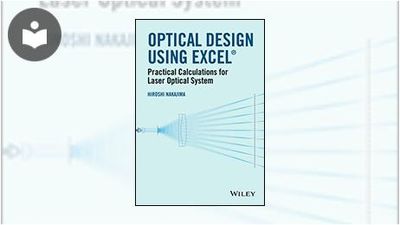Optical Design Using Excel: Practical Calculations for Laser Optical Systems
- 3h 44m
- Hiroshi Nakajima
- John Wiley & Sons (US)
- 2015
A practical introductory guide to optical design covering geometrical optics, simple wave-optics and diffraction, using Excel software
- explains practical calculation methods for designing optical systems with fully worked-out examples and avoiding complex mathematical methods
- includes practical calculations for ray tracing, laser beam (Gaussian beam) focusing, and diffraction calculations; the ray tracing and the diffraction calculations are done by using the VBA program which Excel provides as a supporting tool
- describes basic optical theory and application methods, and provides readers with calculation methods for designing laser optical systems with numerous practical calculation examples. After finishing the book, even inexperienced readers should have the ability to design laser optical systems
- covers large areas of geometrical optics and diffraction theory, providing a good overview and reference for beginners or non-specialist engineers
About the Author
Hiroshi Nakajima graduated from Doshisha University (Kyoto, Japan) with a degree in electronics. From 1967 to 2002, he worked for Hitachi Electronics Engineering Co., Ltd, as an engineer. He was responsible for developing automated manufacturing systems for a variety of electrical products, including the following: automatic adjustment systems for color picture tubes (CPTs), optical inspection systems for the silicon wafer surfaces of integrated circuits (ICs), and optical inspection systems for hard disk (HD) surfaces. From 2003 to 2012, he worked for Hitachi Electronics Engineering Co. and Hitachi High-Technologies Corporation as a technical consultant. During this time, he was responsible for developing optical inspection systems for HD surfaces. The author's specialty is developing machines which are capable of detecting microscopic surface defects (less than 0.1 µm in diameter) using laser optical systems. This book is largely based on his practical experience of working with laser optical systems.
In this Book
-
Geometrical Optics
-
Examples of Simple Optical Design Using Paraxial Theory
-
Ray Tracing Applications of Paraxial Theory
-
Two-Dimensional Ray Tracing
-
Three-Dimensional Ray Tracing
-
Mathematical Formulae for Describing Wave Motion
-
Calculations for Focusing Gaussian Beams
-
Diffraction—Theory and Calculations
-
Calculations for Gaussian Beam Diffraction



